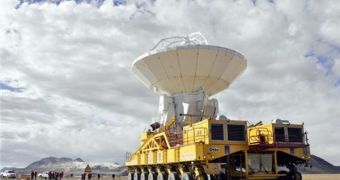The Atacama Large Millimeter/submillimeter Array (ALMA) is one of the world's most powerful telescopes, and also one that is placed in an ideal position to observe the Universe. Situated atop the 5,000-meter plateau of Chajnantor, in the Chilean Andes, the array benefits from exquisite meteorological and atmospheric conditions to probe the skies to huge depths, in radio wavelengths. The entire ensemble is, in fact, a large interferometer, which means that the array acts like a single, huge dish. Recently, a new antenna was delivered to the plateau, by a custom-built, giant transporter.
The machine was especially designed to carry the huge antenna to a height of 5,000 meters (16,400 feet). The new observatory has a diameter of 12 meters, and weighs in at around 100 tons. Because of the harsh conditions at ALMA, where oxygen concentrations in the air are just half those at sea level, the antennas are first assembled and tested at the ALMA Operations Support Facility, located at a more decent altitude, of only 2,900 meters (9,500 feet).
“This is an important moment for ALMA. We are very happy that the first transport of an antenna to the high site went flawlessly. This achievement was only possible through contributions from all international ALMA partners: this particular antenna is provided by Japan, the heavy-lift transporter by Europe, and the receiving electronics inside the antenna by North America, Europe, and Asia,” the European ALMA Project Manager, Wolfgang Wild, says. It took about seven hours for the massive transporter, named Otto, to deliver the antenna to its destination, following a 28-kilometer trip.
Though the machine is capable of reaching speeds up to 12 kilometers per hour with its massive load, the trip, which was the first of its kind, was made a lot slower, so as to ensure that everything went according to plan. With the new addition, the ALMA again reaffirms its role as the leading and most sensitive submillimeter-wavelength array ever made. It operates openly in the harsh environment of the high Andes, and can function at temperatures between +20 and -20 degrees Celsius.
“Transporting our first antenna to the Chajnantor plateau is a epic feat which exemplifies the exciting times in which ALMA is living. Day after day, our global collaboration brings us closer to the birth of the most ambitious ground-based astronomical observatory in the world,” ALMA Director Thijs de Graauw adds. When the array is completed, it will feature 66 antennas spread over 18.5 kilometers. All of these components will act like a single telescope, allowing its scientists to distinguish features as small as a golf ball at a distance of 15 kilometers, ScienceDaily reports.

 14 DAY TRIAL //
14 DAY TRIAL //